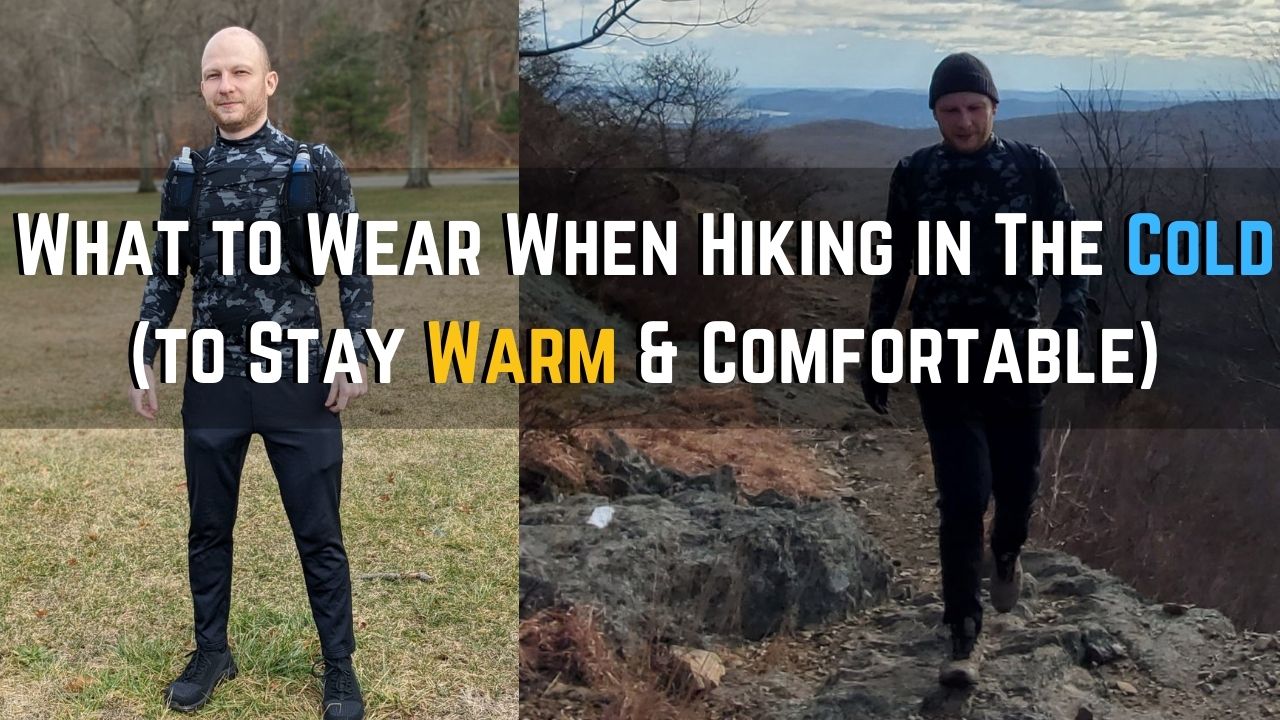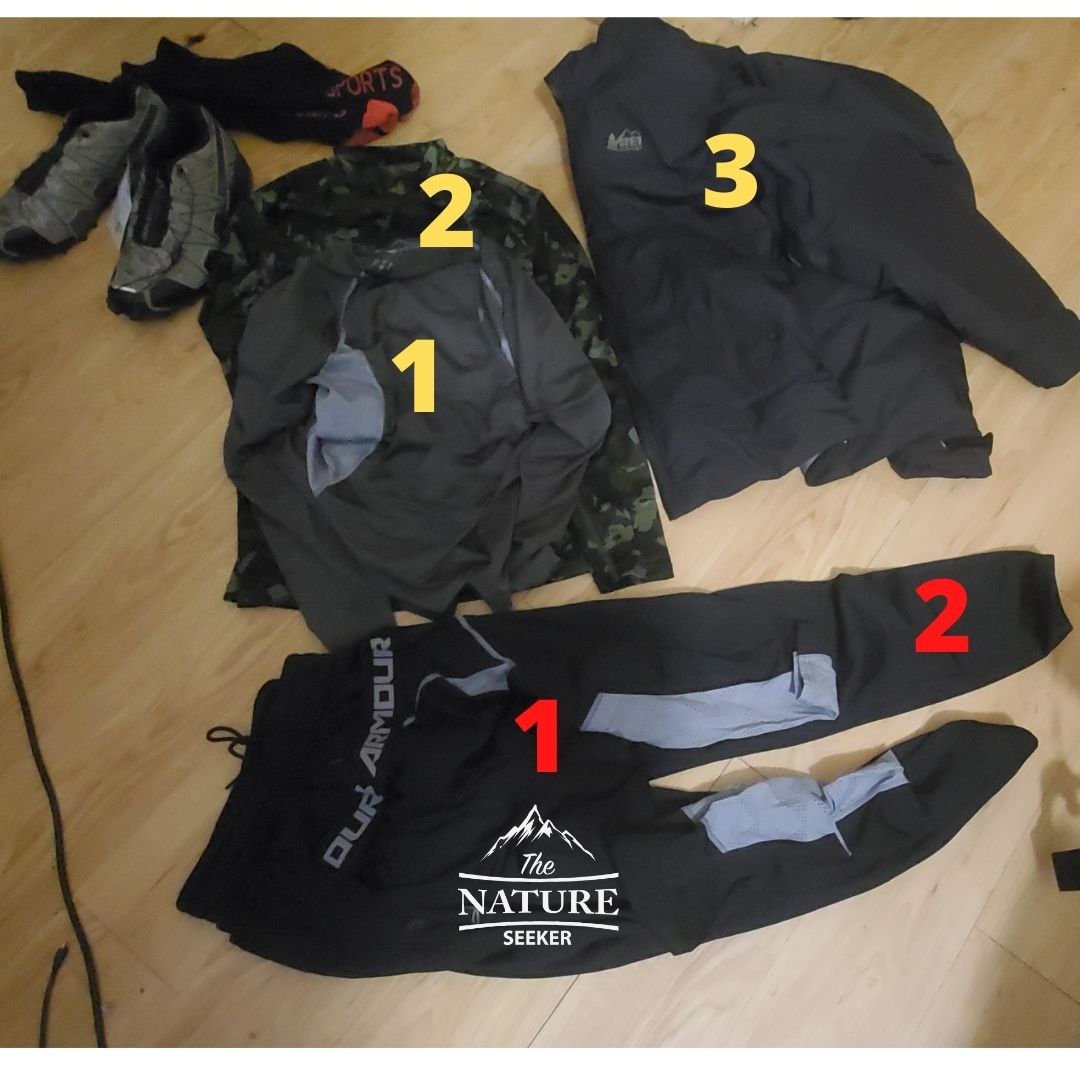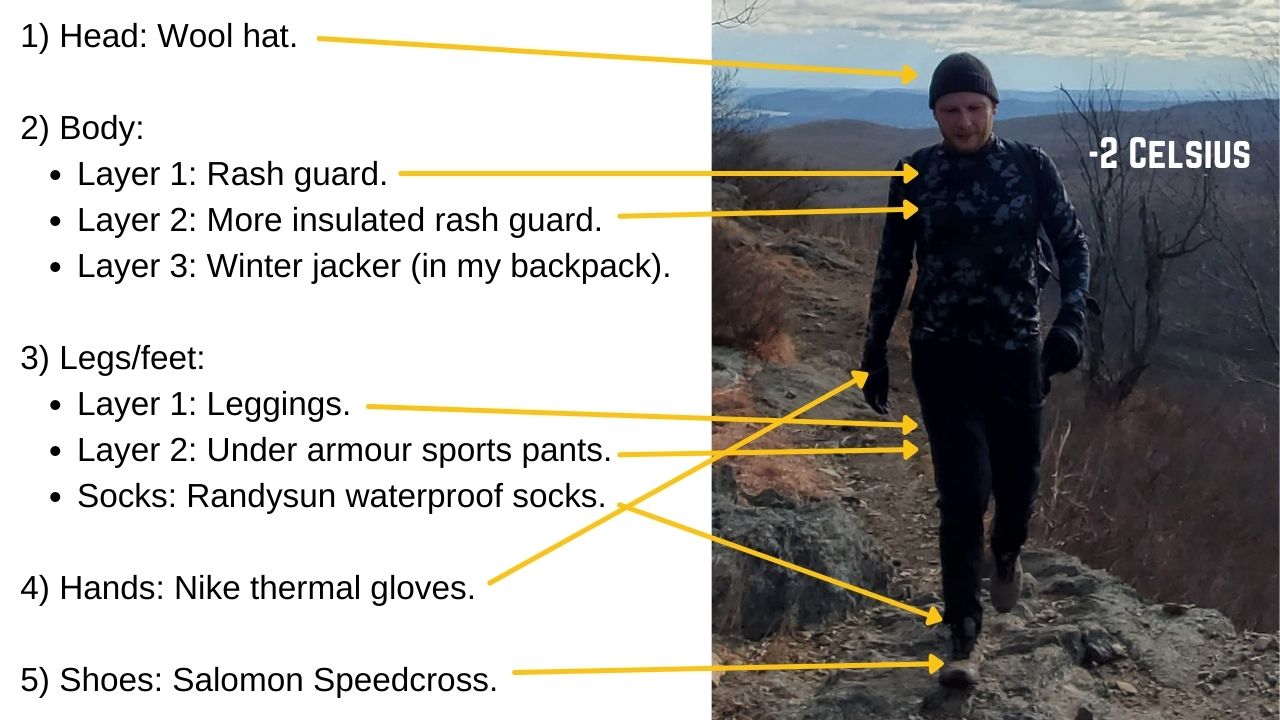What to Wear to When Hiking in Cold Weather to Stay Warm

I’ve done a lot of hiking in cold weather and I have to say, when you know what to wear for the occasion, it’s very easy to stay warm (without sweating too much or overheating) and in this post, I’d like to give you some simple tips on that.
One thing you should note though is that depending on the type of hike you do and how cold it is, depends on what you should wear for it.
 For example:
For example:
 What I follow is a layering process. First, for my body:
What I follow is a layering process. First, for my body:
 At the starting time of the hike, it was 27 degrees cold (-2 Celsius). I started the hike wearing all 3 layers of clothing (1 rash guard on my body, a more insulated rash guard on top of that and my winter jacket).
As we got higher and higher into the mountains, it got to a point where I was feeling very hot from all the incline (nothing gets your body temperature up like incline hikes people). And so as soon as I felt the sweat coming on, I took the jacket off, stuffed it into my backpack and continued the remainder of the hike with just my 2 layers (the rash guards).
The first layer incubated my heat and the second layer basically held it in. Thus I was able to walk, hike and trail run very comfortably through this hike without ever really feeling cold.
In fact, people who saw me do this hike on Instagram thought I was crazy for wearing so little, but once you understand layering and how well good rash guards insulate heat, it makes perfect sense.
At any point in time, if I were to sit down or take a break, my body would cool down and I’d likely get the jacket back out to stay warm, but once I’d start moving again, it would come off again.
In other words, like I said before, I’d simply use these 3 layers and adjust my hike in the cold so that I would stay warm, but at the same time not sweat too much or feel overheated. Believe me, the last thing you want is to sweat a lot or overheat on a cold hike (that’ll get you sick).
For the lower part of my body, I didn’t need as much to keep me warm and in this case, 2 layers of pants (one rash guard, the other regular sports pants) were enough. The waterproof socks I typically wear, are very insulated and at no point in time did I ever feel cold. Even if I stepped into a puddle, they’d protect me.
At the starting time of the hike, it was 27 degrees cold (-2 Celsius). I started the hike wearing all 3 layers of clothing (1 rash guard on my body, a more insulated rash guard on top of that and my winter jacket).
As we got higher and higher into the mountains, it got to a point where I was feeling very hot from all the incline (nothing gets your body temperature up like incline hikes people). And so as soon as I felt the sweat coming on, I took the jacket off, stuffed it into my backpack and continued the remainder of the hike with just my 2 layers (the rash guards).
The first layer incubated my heat and the second layer basically held it in. Thus I was able to walk, hike and trail run very comfortably through this hike without ever really feeling cold.
In fact, people who saw me do this hike on Instagram thought I was crazy for wearing so little, but once you understand layering and how well good rash guards insulate heat, it makes perfect sense.
At any point in time, if I were to sit down or take a break, my body would cool down and I’d likely get the jacket back out to stay warm, but once I’d start moving again, it would come off again.
In other words, like I said before, I’d simply use these 3 layers and adjust my hike in the cold so that I would stay warm, but at the same time not sweat too much or feel overheated. Believe me, the last thing you want is to sweat a lot or overheat on a cold hike (that’ll get you sick).
For the lower part of my body, I didn’t need as much to keep me warm and in this case, 2 layers of pants (one rash guard, the other regular sports pants) were enough. The waterproof socks I typically wear, are very insulated and at no point in time did I ever feel cold. Even if I stepped into a puddle, they’d protect me.
 For example:
For example:
- Are you doing a regular walk in the woods or are you trail running?
- Is it a high elevation hike?
- Is it a trail run on a high or low elevation?
- How cold do you expect the weather to be the day you go? Is it chilly or literally freezing?
Here’s what I usually wear when I go hiking in cold weather:
 What I follow is a layering process. First, for my body:
What I follow is a layering process. First, for my body:
- Layer one (on my body): Rash guard. Here is a good one.
- Layer two (on top of the rashguard): A more insulated rash guard (I recommend the Kanu Surf Boys Platinum rash guard).
- Layer three (on top of that): A good winter jacket. I wore the REI Co Op 850 Down Jacket.
- Layer 1 (for my legs): Leggings. Any basic leggings will do.
- Layer 2 (decent hiking pants): I typically wear under armor or waterproof pants (no jeans for these types of hikes).
- For my feet: Just waterproof socks are usually enough. I wore the Randysun Waterproof socks for this hike.
- For shoes, I wear either the Salomon Speedcross 5 or the Merrell Moab Speed shoes. Something that is great for protection from both the weather and insulating heat (definitely wouldn’t wear something like crocs for hiking here!).
- I only wore thermal Nike Gloves.
- A wool hat is typically good for hikes.
An example of how wearing this protects me from the cold weather (and keeps me warm):
Just last week I went on an 11 mile hike with a buddy of mine to Harriman State Park. You can see a picture of me getting on this hike here: At the starting time of the hike, it was 27 degrees cold (-2 Celsius). I started the hike wearing all 3 layers of clothing (1 rash guard on my body, a more insulated rash guard on top of that and my winter jacket).
As we got higher and higher into the mountains, it got to a point where I was feeling very hot from all the incline (nothing gets your body temperature up like incline hikes people). And so as soon as I felt the sweat coming on, I took the jacket off, stuffed it into my backpack and continued the remainder of the hike with just my 2 layers (the rash guards).
The first layer incubated my heat and the second layer basically held it in. Thus I was able to walk, hike and trail run very comfortably through this hike without ever really feeling cold.
In fact, people who saw me do this hike on Instagram thought I was crazy for wearing so little, but once you understand layering and how well good rash guards insulate heat, it makes perfect sense.
At any point in time, if I were to sit down or take a break, my body would cool down and I’d likely get the jacket back out to stay warm, but once I’d start moving again, it would come off again.
In other words, like I said before, I’d simply use these 3 layers and adjust my hike in the cold so that I would stay warm, but at the same time not sweat too much or feel overheated. Believe me, the last thing you want is to sweat a lot or overheat on a cold hike (that’ll get you sick).
For the lower part of my body, I didn’t need as much to keep me warm and in this case, 2 layers of pants (one rash guard, the other regular sports pants) were enough. The waterproof socks I typically wear, are very insulated and at no point in time did I ever feel cold. Even if I stepped into a puddle, they’d protect me.
At the starting time of the hike, it was 27 degrees cold (-2 Celsius). I started the hike wearing all 3 layers of clothing (1 rash guard on my body, a more insulated rash guard on top of that and my winter jacket).
As we got higher and higher into the mountains, it got to a point where I was feeling very hot from all the incline (nothing gets your body temperature up like incline hikes people). And so as soon as I felt the sweat coming on, I took the jacket off, stuffed it into my backpack and continued the remainder of the hike with just my 2 layers (the rash guards).
The first layer incubated my heat and the second layer basically held it in. Thus I was able to walk, hike and trail run very comfortably through this hike without ever really feeling cold.
In fact, people who saw me do this hike on Instagram thought I was crazy for wearing so little, but once you understand layering and how well good rash guards insulate heat, it makes perfect sense.
At any point in time, if I were to sit down or take a break, my body would cool down and I’d likely get the jacket back out to stay warm, but once I’d start moving again, it would come off again.
In other words, like I said before, I’d simply use these 3 layers and adjust my hike in the cold so that I would stay warm, but at the same time not sweat too much or feel overheated. Believe me, the last thing you want is to sweat a lot or overheat on a cold hike (that’ll get you sick).
For the lower part of my body, I didn’t need as much to keep me warm and in this case, 2 layers of pants (one rash guard, the other regular sports pants) were enough. The waterproof socks I typically wear, are very insulated and at no point in time did I ever feel cold. Even if I stepped into a puddle, they’d protect me.
How to adjust your clothing layers according to the hike and weather:
It’s really simple:- Again, go by how you feel and how you SHOULD feel is comfortable at all times where you’re not sweating or overheating. If you feel like you’re overheating, remove a layer (or two).
- If you’re feeling very cold, add a layer (or two).
- Now like I said, the type of hike you do, how cold it gets, and at what pace you go at also highly depends. Let me explain:
- If you’re just doing a regular walk in the woods, there’s a good chance you’ll be wearing all 3 layers (on your upper body) throughout most of the hike.
- If you’re jogging or trail running in the woods and the elevation is pretty flat with mild inclines and declines, you’ll work up more of a sweat and likely have to remove your top layer (winter jacket).
- If you’re walking up a high elevation, this is where you’ll likely heat up the fastest. Nothing gets me sweating like incline hiking, so be prepared to remove a layer if that happens.

Love the idea of the layering, and with good quality clothing, you can make sure that the material will be both warm and keep you from overheating at the same time. This is the first time that I have heard of a rash guard, and why would you need that in a top and not pants?
Waterproof socks are a must on any hike, and I have learned this the hard way as there is nothing more uncomfortable than walking with soaked socks, and there is a higher chance of getting blisters on your feet.
You can wear a rashguard beneath your pants, but they are referred to as leggings in that case Michel.
I am heading to Alaska with a friend to visit my dad. We plan on doing some hiking, so this is great information. My dad says he has all I need, but ummm he’s not the same size and I really want to do this right. I plan on checking into your recommendations. Since my dad lives in Alaska, I can leave the gear there and reuse on my next visit ! Thanks for the great information.
I think if you buy layered clothing that fits you according to this post’s guidance, you should be totally fine in Alaska Lea. Enjoy your trip!
I have been looking for more hiking gear to keep me warm during the winter season. Last month, I was going to buy winter hiking pants by Froggtoggs, but waited to do further research.
Now that you’ve explained the layers and how to adjust, I’m excited for my next hike. I’ll be sure not to don’t forget a spicy snack, another great tip! Thank you for this post.
You’re welcome! I’ve never heard of the hiking pants you mentioned, but if they’re good and affordable, I would get them. Personally you don’t need to buy expensive gear to stay warm and layering is a great way to make sure you feel great when it’s cold.